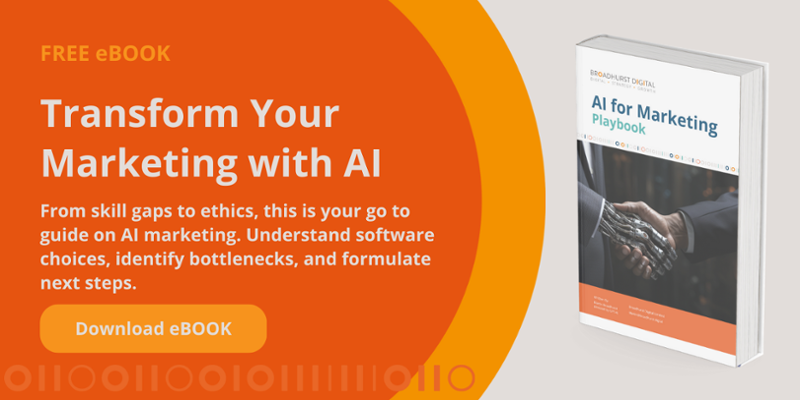This article is a summarised version of the journal article How businesses of any size can use AI in a digital marketing strategy, published in Applied Marketing Analytics Volume 8 Number 2 by Henry Stewart Publications.
When it comes to implementing AI/ML tools into their business, companies will vary according to a number of factors, including the company’s resources and data. To help give business leaders a sense of how best to utilise AI/ML within their marketing function, they can use the AI/ML marketing deployment matrix.

AI/ML marketing deployment matrix
We are at the very beginning of an AI revolution. In markets around the world, AI technology is disrupting the old way of doing things. Businesses must now adopt or risk being left behind.
The use cases for artificial intelligence in marketing are vast and in the coming years we will see some incredible case studies from the leaders in the field who are developing their own models. For most marketing professionals, this will continue to be a world away from their day-to-day reality. Yet AI will continue to be built into the tools that digital marketing professionals use every day; from Google Analytics to Mailchimp, AI will increasingly be ‘under the hood’ of the marketing technology that businesses, large and small, deploy.

In order to understand how best to utilise AI/ML within their marketing function, business leaders can use the AI/ML marketing deployment matrix. This is a simple framework that aims to steer marketing leaders towards the most appropriate AI/ML use cases and solutions for their organisation.
The AI/ML marketing deployment matrix is a two by two matrix. On the vertical axis is the amount of resources (human, financial) a business has. The lower half represents businesses with smaller teams and budgets and the upper half a larger teams and budgets. The horizontal axis is the amount and the quality of data a business has. The left hand side represents a small amount of data, the right hand side a large amount of data. Good quality is that which is well-structured and readily accessible (eg e-commerce transaction data, or user engagement data within an app).
Low resource, low data businesses
The quadrant in the lower left hand side represents businesses with a small amount of resource and a small amount of data. In this quadrant we find many solopreneurs and micro-businesses. These businesses have small amounts of data (little or no CRM), few resources and a lot of the marketing effort focuses on increasing reach through social media, advertising, or SEO. The management of the marketing will often fall at the feet of the business owner/manager.
A recent survey of 1,000 SMBs found small businesses consider social media their most successful digital marketing tool in 2022. Yet social media also presents challenges for small owner-managed businesses as social media network algorithms reward fresh content and demand engagement. As a result, the average half-life duration for Facebook posts is just 60 minutes. For time-poor business owners, creating new content for their social media marketing channels can often take longer than the lifespan of the post.
Given the demands on micro-business owners who wear many hats and find themselves responsible for marketing, finance, sales, service and more, AI that can improve the efficiency of any tasks should be embraced with open arms. For these resource-poor and data-lite businesses, the best use of AI comes from using AI to perform repetitive tasks, such as producing content or providing simple analysis of marketing campaign performance through free tools such as Google Analytics.
In the last twelve months, many small businesses have been able to benefit from the release of many new AI large-language models (LLMs), such as OpenAI’s GPT-3 and AI21’s Jurassic model. These LLMs can be used to manage repetitive tasks or to assist with content creation. For example, GPT-3 powered AI writing tools can greatly reduce the amount of time spent writing marketing copy or producing social media content. For a small business owner looking to have an active digital marketing presence while managing the rest of their business, AI can remove writer’s blocks and help to ensure they continue to reach and engage with audiences on social media.
Low resource, high data businesses
In the upper left hand quadrant, we find organisations with more data but still lacking in resources. These will often be small businesses with business models that produce high levels of data, such as e-commerce or SaaS technology start-ups. In this quadrant, businesses have more data to work with, but may not have the resource to make use of it effectively.
For businesses in this quadrant, the best use of AI is to analyse the company’s first-party data to improve marketing processes, such as identifying opportunities for customer segmentation or automating tasks using customer data.
Take one of the most expensive functions for a growing business: customer service. Businesses, particularly those who have customers using their services around the clock (such as e-commerce or SaaS companies), are increasingly expected to offer round-the-clock customer care but doing so is resource heavy and expensive. This is where using AI to deliver personalised customer service is extremely effective.
Modern customers are prepared to help themselves and are increasingly less reliant on customer support interactions. In ‘The Zendesk Customer Experience Trends Report 2020’ by Zendesk, 69 per cent of consumers first try to resolve their issue on their own.
Companies can support customers to do this by using AI chatbots that can be accessed by customers through the channels that they find most convenient, such as WhatsApp, Facebook Messenger, or website live chat. When connected to sources of customer data, such as e-commerce platforms (eg Shopify, WooCommerce) or CRM (eg HubSpot, Salesforce), AI Chatbots can provide first-line customer support capable of resolving simple customer service issues, such as handling return requests, or redirecting customers to a knowledge base article that answers their question.
High resourced, low data businesses
The lower right hand quadrant represents businesses with more resources but not so much data, or a poor management of any data that they have. Companies that fall into this bracket may look like ‘traditional’ businesses — manufacturing business, professional services — businesses that have sales and marketing resources, but they lack a quality data management process. Where there is a CRM in place, it may be poorly maintained or siloed from other products due to a lack of integrations.
In such circumstances, whilst the business may have a sales and marketing team that can execute, they lack sufficient first-party data, so AI cannot be used to automate customer service requests or provide insights into customer segmentation strategies. Instead, companies can use AI powered products that make use of third-party or publicly available data to inform their strategy. This could be in the form of SEO strategy, buyer persona development, or market research.
In these instances, companies should look to off-the-shelf solutions that are well-trained and already delivering value for customers. AI tools operating in the Natural Language Processing (NLP) space such as Marketmuse, use Natural Language Programming AI to assess online content which can help businesses understand what content is missing from their website, or what topics they should be writing about to rank higher in search engines.
High resource, high data businesses
The final quadrant, in the upper right hand side, is where we find companies with both a lot of resource and data. These businesses have made a significant investment in collecting and managing their data and as a result have a lot of data to work with. Enterprise organisations will typically fall into this category.
In this quadrant, businesses can use AI for a variety of tasks, including customer segmentation, predictive analytics and identifying opportunities for marketing and sales efficiencies. Not only can these organisations make use of all of the previously mentioned technologies and use cases, but these organisations have the resources to train and develop their own models.
Businesses in this category have vast amounts of data and the resources to create AI/ML models uniquely designed to solve the challenges of their business. While they can use off-the-shelf AI software and will be using ready-made solutions for standard marketing optimisation (eg email marketing send-time optimisation), they will see the biggest impact when they design their own AI/ML programs for their organisations.
It is in this quadrant that we will see the highest volume of AI/ML projects failing. Creating new ML models is difficult; common challenges such as navigating ethical concerns and managing biases, as well as the myriad other challenges associated with deploying new technologies at scale, will continue to exist. But for those companies that have the means to dedicate resources to AI/ML development within the organisation, they will only need a few successful projects to realise significant gains. This is why Google, Microsoft, Amazon, NVidia, Meta and Apple are investing so heavily into AI/ML technology.
Limitations of the AI/ML marketing deployment matrix
The quadrants as described will not neatly contain all businesses; for example, there will be micro-businesses with immense data science talent and access to vast troves of data who do not appear to slot neatly into the matrix.
This simple matrix is not intended to describe the world perfectly. In fact, it is not supposed to describe the world at all. Instead, it is intended to be an inspirational tool for marketing professionals who are interested in AI/ML but don’t know where to start. It should inspire marketing professionals to ask questions about their organisation and to understand how best to see some early successes through the deployment of AI/ML products or services.

Comments